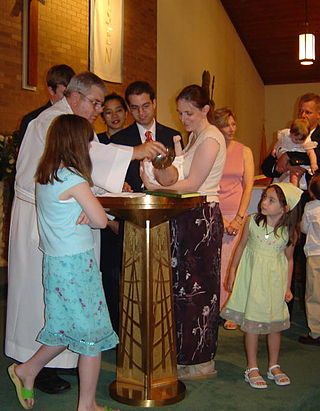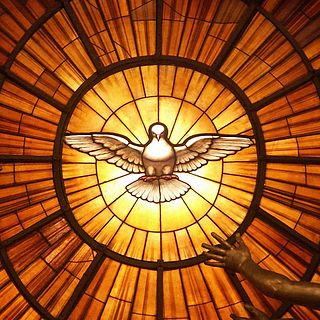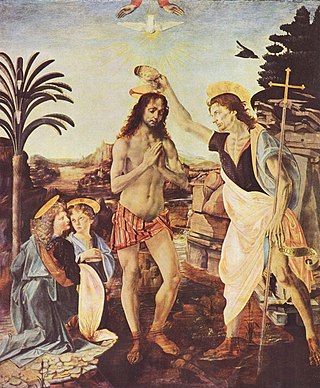
Infant baptism is the practice of baptizing infants or young children. Infant baptism is also called christening by some faith traditions.
The charismatic movement in Christianity is a movement within established or mainstream Christian denominations to adopt beliefs and practices of Charismatic Christianity, with an emphasis on baptism with the Holy Spirit, and the use of spiritual gifts (charismata). It has affected most denominations in the United States, and has spread widely across the world.
In Christian theology, baptism with the Holy Spirit, also called baptism in the Holy Spirit or baptism in the Holy Ghost, has been interpreted by different Christian denominations and traditions in a variety of ways due to differences in the doctrines of salvation and ecclesiology. It is frequently associated with incorporation into the Christian Church, the bestowal of spiritual gifts, and empowerment for Christian ministry. Spirit baptism has been variously defined as part of the sacraments of initiation into the church, as being synonymous with regeneration, or as being synonymous with Christian perfection. The term baptism with the Holy Spirit originates in the New Testament, and all Christian traditions accept it as a theological concept.
The Jesus Army, also known as the Jesus Fellowship Church and the Bugbrooke Community, was a neocharismatic evangelical Christian movement based in the United Kingdom, part of the British New Church Movement. The name Jesus Army was specifically used for the outreach and street-based evangelism for which they were known.

The Couples for Christ (CFC) is an international Catholic lay ecclesial movement whose goal is to renew and strengthen Christian values. It is one of 123 International Associations of the Faithful.

The Catholic Charismatic Renewal (CCR) is a movement within the Catholic Church that is part of the wider charismatic movement across historic Christian churches.
Logos Foundation was an influential and controversial Christian ministry that flourished in Australia in the 1970s and 1980s under the leadership of Howard Carter, originally a Baptist pastor from Auckland, New Zealand. Logos Foundation was initially a trans-denominational charismatic teaching ministry, primarily Protestant but with some ties to Catholic lay groups and individuals.

The Society of the Divine Word, abbreviated SVD and popularly called the Verbites or the Divine Word Missionaries, and sometimes the Steyler Missionaries, is a Catholic clerical religious congregation of Pontifical Right for men. As of 2020, it consisted of 5,965 members composed of priests and religious brothers working in more than 70 countries, now part of VIVAT international. It is one of the largest missionary congregations in the Catholic Church. Its members add the nominal letters SVD after their names to indicate membership in the Congregation. The superior general is Paulus Budi Kleden who hails from Indonesia.

People of Praise is a network of lay Christian intentional communities. As a parachurch apostolate, membership is open to any baptized Christian who affirms the Nicene Creed and agrees to the community's covenant. The majority of its members are Catholics, but Protestants can also join, reflecting the ecumenical nature of People of Praise. It has 22 branches in the United States, Canada, and the Caribbean, with approximately 1,700 members. It founded Trinity Schools, which are aligned with the philosophy of classical Christian education.
The Word of God is an ecumenical, charismatic, missionary Christian community in Ann Arbor, Michigan. The community began in 1967.

Peter Leo Gerety was an American prelate of the Roman Catholic Church. He served as the Archbishop of Newark in New Jersey from 1974 to 1986, having previously served as Bishop of Portland in Maine from 1969 to 1974. Gerety was the oldest living Catholic bishop in the world at the time of his death at age 104.
Mother of God Community is a Catholic and ecumenical charismatic community located in the Washington, D.C. metropolitan area of the United States. The Community office and grounds is located in Gaithersburg, Maryland. Under the Canon Law of the Catholic Church, the Community is recognized as a "private association of the faithful" with its governing statutes approved by the Archbishop of Washington. In addition the Community is a member of the Catholic Charismatic Renewal International Service (CHARIS) established in the Vatican by the Holy See. The Community is also a founding member of the Association of Ecclesial Movements and New Communities in the Roman Catholic Archdiocese of Washington as well as the North American Network of Charismatic Covenant Communities. Individual members of the Mother of God Community believe they are called to live out the Gospel of Jesus Christ and to grow in the knowledge of God through daily prayer, fellowship, evangelization, and service to the Church. Membership is open to Christians from all walks of life – families, couples, priests, and singles, college students, seminarians, and retired people. There are members and affiliate members, but only about a dozen members actually live in the Community's large residential house.
The Missionary Families of Christ (MFC), formerly known as Couples for Christ - Foundation for Family and Life (CFC-FFL) is a Philippine-based Catholic charismatic lay community that emphasizes individual renewal, family life renewal, Church renewal, societal renewal and evangelization. MFC is a missionary body, and the families and individuals that make up this association are to strive to be instruments of the Holy Spirit in renewing the face of the earth.

The Movement of the Word of God, also called Work of God the Father, is a pastoral community of disciples, a lay ecclesial movement within the Roman Catholic Church.

Jesus Youth(JY) is an International Catholic Movement, approved by the Holy See.
Vincent Michael Scanlan, T.O.R. was a Catholic priest of the Franciscan Third Order Regular. He was responsible for the revival of the College of Steubenville, now known as Franciscan University of Steubenville. Scanlan served the university for 26 years as president and then 11 years as chancellor, before retiring in 2011. He resided at the Sacred Heart Province motherhouse in Loretto, Pennsylvania, prior to his death on January 7, 2017.

The Brotherhood of Hope is an association of the faithful in the Catholic Church, composed primarily of religious brothers who serve in college campus ministry. They are also a member of an association of charismatic communities called the Sword of the Spirit
The Catholic charismatic renewal is a recent movement in the Catholic Church to re-emphasize the charisms of the Holy Spirit in lay people's everyday lives.
Charismatic Christianity is a form of Christianity that emphasizes the work of the Holy Spirit and spiritual gifts as an everyday part of a believer's life. It has a global presence in the Christian community. Practitioners are often called Charismatic Christians or Renewalists. Although there is considerable overlap, Charismatic Christianity is often categorized into three separate groups: Pentecostalism, the Charismatic movement, and the Neo-charismatic movement.
Ralph C. Martin is a professor at Sacred Heart Major Seminary and was involved in the early Catholic charismatic renewal as founder of the Word of God (community) and cofounder of the Sword of the Spirit association of covenant communities.









